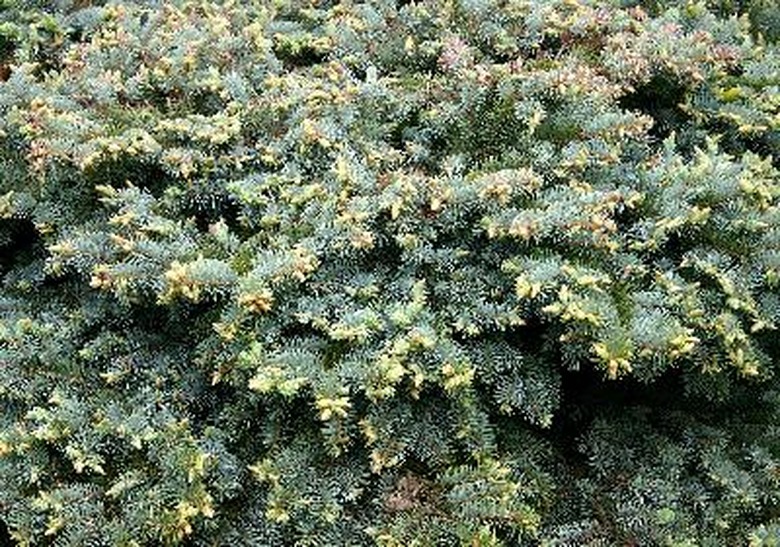The Best Evergreen Hedges For Texas
Texas is a large state with growing conditions that range from the tropical atmosphere of the Gulf Coast to the arid mountains of West Texas. If you are looking for the best evergreen hedges for Texas, look for attractive shrubs that can be sheared to form a dense hedge. Also, look for shrubs tolerant of extreme weather conditions, resistant to insect and disease damage, and suitable for planting in most parts of the state.
Dwarf Evergreen Hedge Plants
Compact shrubs that grow to 1 to 3 feet tall make attractive borders and hedges. Once mature, they rarely need pruning as they have a natural dense growth habit. The dwarf yaupon holly (Ilex vomitoria nana) has small leaves and forms a natural mounding growth habit. The dwarf Chinese holly (Ilex cornuta rotunda) has bright-green sharp spiny leaves that remain attractive all year. Dwarf burford holly (Ilex cornuta rotunda burfordii) has attractive shiny green leaves without the sharp spines of the Chinese holly. Like all burford hollies, the dwarf variety forms berries on all the plants without cross-pollination.
- Texas is a large state with growing conditions that range from the tropical atmosphere of the Gulf Coast to the arid mountains of West Texas.
- The dwarf yaupon holly (Ilex vomitoria nana) has small leaves and forms a natural mounding growth habit.
Small Evergreen Hedge Plants
Evergreens for hedging that grow from 3 to 5 feet make a friendly hedge between homes or to designate a border. Nandina Compacta (Nandina domestica compacta) is a tropical-looking plant resembling bamboo. The jointed canes grow from the ground with minimal lateral branching. It is pruned by cutting the tallest cane at ground level. Japanese Boxwood (Buxus japonica) is a smaller-growing type of boxwood with small bright green leaves and dense growth habit. It grows slow, so pruning once or twice a year is all that is needed. Indian Hawthorne (Raphiolepis indica) blooms pink or white in the spring. The gray-green leaves remain attractive all year. It has an attractive natural shape that rarely needs pruning. Glossy abelia (Abelia grandiflora) also has spring blooms. Occasional pruning helps remove uneven growth appearing in spring.
- Evergreens for hedging that grow from 3 to 5 feet make a friendly hedge between homes or to designate a border.
- Japanese Boxwood (Buxus japonica) is a smaller-growing type of boxwood with small bright green leaves and dense growth habit.
Medium Evergreen Hedge Plants
Medium evergreen shrubs grow 6 to 9 feet tall and are often used as a privacy screen. They are also used for covering a wall or other structure. Eleagnus (Eleagnus fruitlandi) has rangy natural growth that is kept in check by regular pruning that creates an attractive dense hedge. Variegated pittosporum (Pittosporum tobira variegata) is often damaged by cold in the panhandle of Texas. However, it is an excellent shrub for planting in the rest of Texas. It is drought tolerant, and unaffected by disease and insects. Variegated pittosporum is slower-growing than most hedges, but is one of the longer-lived evergreen shrubs available.
- Medium evergreen shrubs grow 6 to 9 feet tall and are often used as a privacy screen.
- Variegated pittosporum (Pittosporum tobira variegata) is often damaged by cold in the panhandle of Texas.
Large Evergreen Hedge Plants
Large evergreen hedge plants that grow to 25 feet tall are used for windbreaks, snow breaks and privacy screens. Although the cherry laurel (Prunus caroliniana) is not suitable for the cold winters of the Texas panhandle, it tolerates shade. Several varieties are available with differing growth habits, such as pyramidal growth or spreading tree-like forms. Junipers (Juniperus sp.) are not recommended for southern Texas, from San Antonio to the Mexican border, but many other varieties are available. The yaupon holly (Ilex vomitoria) is used throughout the state as a versatile hedge plant. It can be sheared as needed and is fast-growing. Improved varieties include those with weeping, dwarf and columnar forms.
- Large evergreen hedge plants that grow to 25 feet tall are used for windbreaks, snow breaks and privacy screens.
- Although the cherry laurel (Prunus caroliniana) is not suitable for the cold winters of the Texas panhandle, it tolerates shade.
